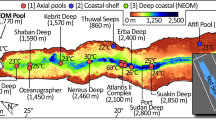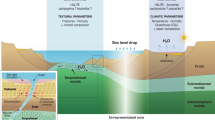Abstract
THE hot salty water discovered in the Red Sea during the Discovery expedition1, and which has also been studied during other expeditions2,3, is widely thought to have come from the highly mineralized ground waters emerging at the sea bottom. It is not clear, however, why the rather common phenomenon of emerging ground waters brings about the formation of abnormal water masses only in the Red Sea. Brine supplied from underwater sources is usually immediately mixed with circulating oceanic water. Miller et al.4 refer to a hypothesis by K. O. Emery which, unfortunately, had not been developed in detail. Emery supposed the hot brine to have been concentrated by evaporation of the water masses of the Red Sea when it was cut off from the oceans during glaciation. This possibility has also been mentioned by Degens and Ross5. Miller put forward a number of objections to Emery's hypothesis, but it is my view that these can be overcome by assuming the basins discovered at the bottom of the Red Sea to have been lakes developed according to limnological laws.
This is a preview of subscription content, access via your institution
Access options
Subscribe to this journal
Receive 51 print issues and online access
$199.00 per year
only $3.90 per issue
Buy this article
- Purchase on Springer Link
- Instant access to full article PDF
Prices may be subject to local taxes which are calculated during checkout
Similar content being viewed by others
References
Swallow, J. C., and Crease, J., Nature, 205, 165 (1965).
Krause, G., and Ziegelbein, J., “Meteor”, Forschungsergebnisse, A, No. 1, 53 (Berlin, 1966).
Hunt, J. M., Hays, E. E., Degens, E. T., and Ross, D. A., Science, 156, 514 (1967).
Miller, A. R., Densmore, C. D., Degens, E. T., Hathaway, J. C., Manheim, F. T., McFarlin, P. F., Pocklington, R., and Jokela, A., Geochim. Cosmochim. Acta, 30, 341 (1966).
Degens, E. T., and Ross, D. A., Oceanus, 13, 28 (1967).
Matthews, D. H., Williams, C., and Laughton, A. S., Nature, 215, 1052 (1967).
Emery, K. O., and Garrison, L. E., Science, 157, 684 (1967).
Wright, C. A., and Brown, D. S., Bull. Brit. Mus. (Nat. Hist.), Zool., 8, 285 (1962).
Wright, C. A., Bull. Brit. Mus. (Nat. Hist.), Zool., 10, 259 (1963).
Vangengeim, E. A., and Ravsky, E. I., Intern. Geol. Cong. 22nd Session, Reps. Sov. Geologists, 16 (in Russian) (Moscow, 1965).
Fairbridge, R. W., in Problems of Palaeoclimatology (1963).
Kvasov, D. D., in Upper Pleistocene, Stratigraphy and Absolute Geochronology (in Russian) (Science, Moscow, 1966).
Craig, H., Science, 154, 1544 (1966).
Brewer, P. Y., Riley, J. P., and Culkin, F., Deep-Sea Res., 12, 497 (1965).
Neumann, A. C., and Chave, K. E., Nature, 206, 1346 (1965).
Livingstone, D. A., Data of Geochemistry (sixth ed.) (1963).
Posokhov, Y. V., Salt Lakes of Kazakhstan (in Russian) (Pub. Acad. Sci., USSR, Moscow, 1955).
Por, F. D., Nature, 218, 860 (1968).
Author information
Authors and Affiliations
Rights and permissions
About this article
Cite this article
KVASOV, D. Limnological Hypothesis of the Origin of Hot Brines in the Red Sea. Nature 221, 850–851 (1969). https://doi.org/10.1038/221850a0
Received:
Issue Date:
DOI: https://doi.org/10.1038/221850a0
Comments
By submitting a comment you agree to abide by our Terms and Community Guidelines. If you find something abusive or that does not comply with our terms or guidelines please flag it as inappropriate.



